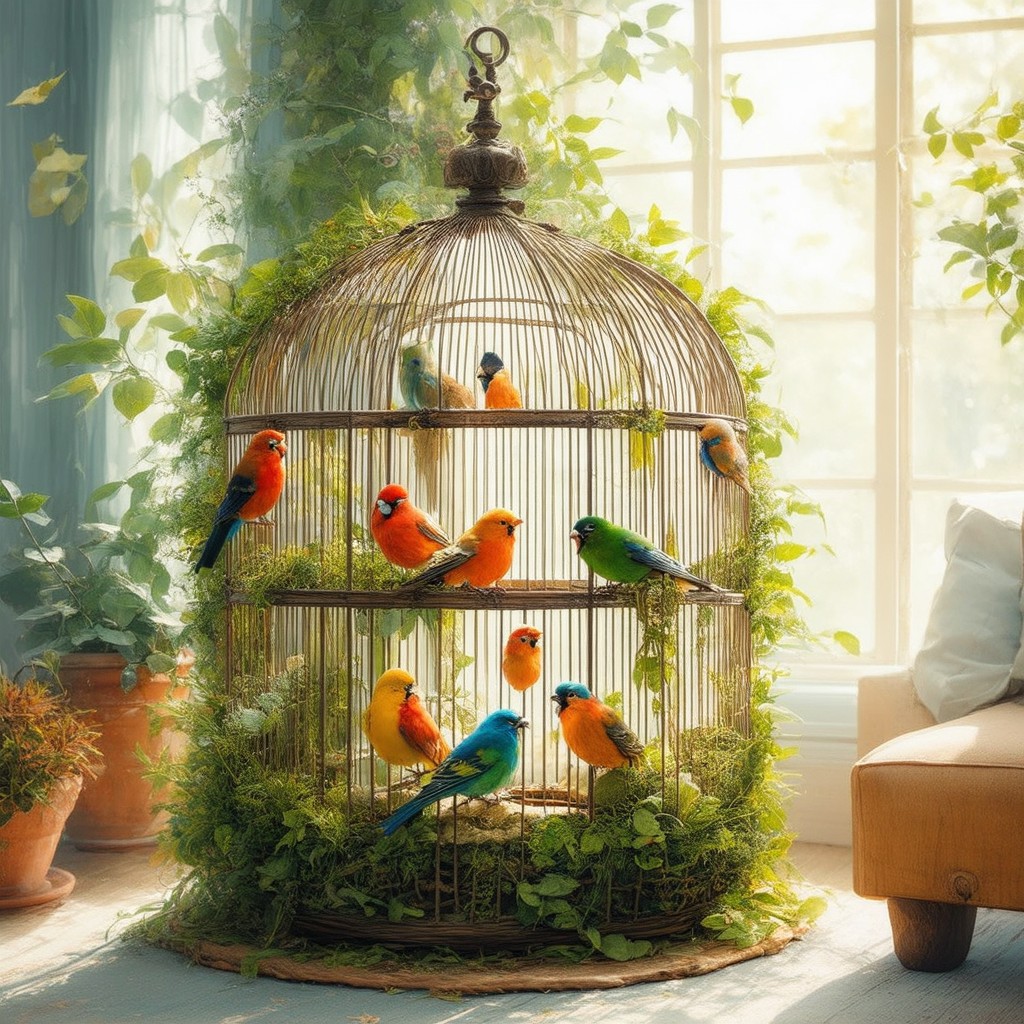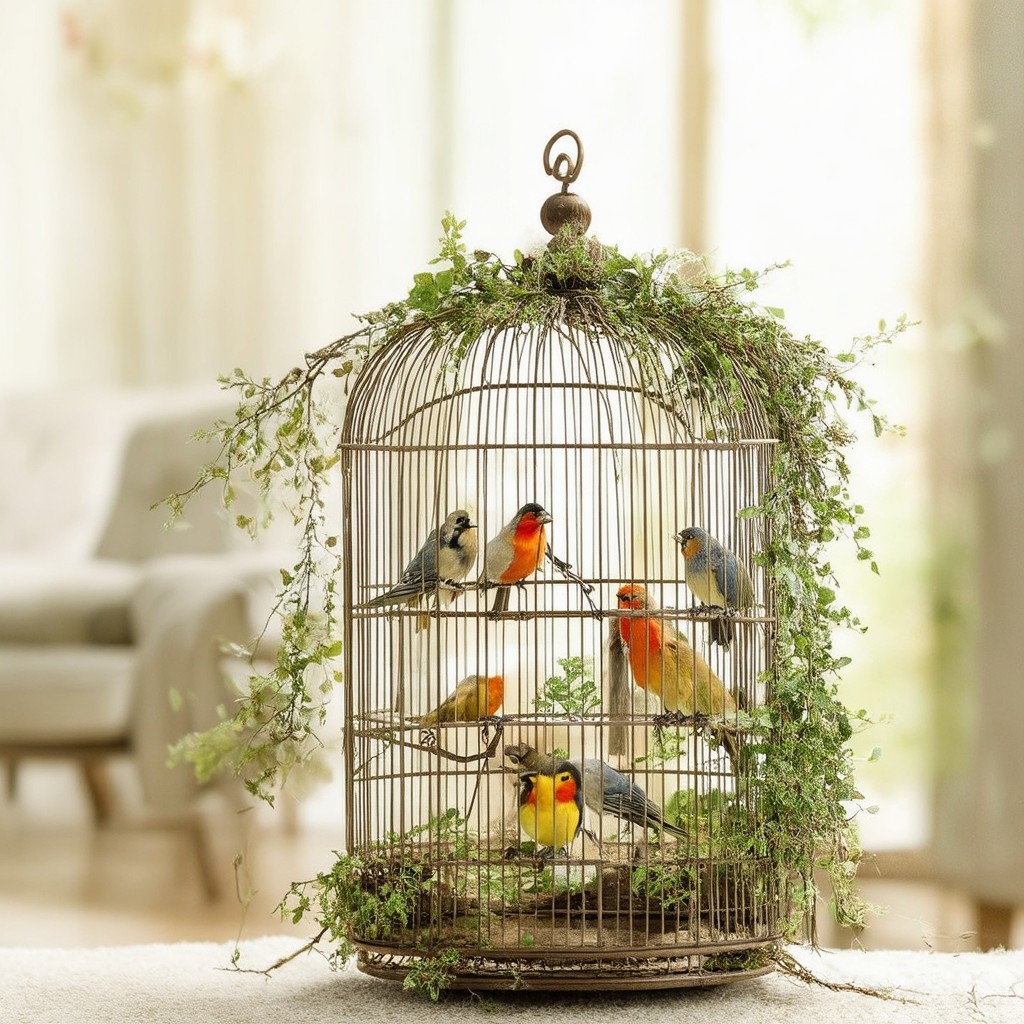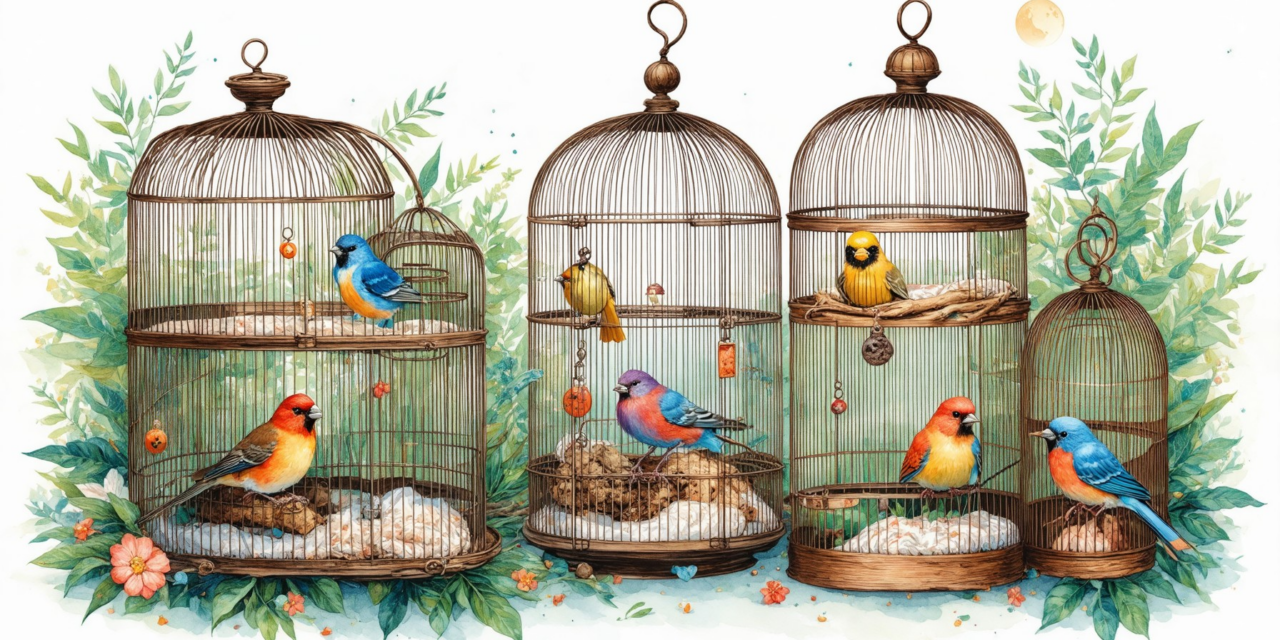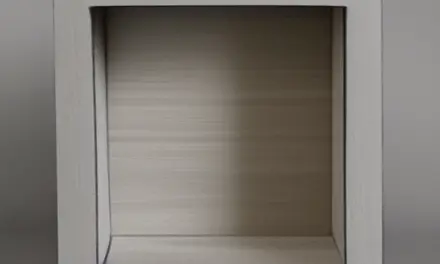Key Takeaways
- Optimal Cage Size: Choose a wider cage over a taller one to promote natural flying and climbing behaviors, ensuring your birds’ physical and mental well-being.
- Comfort and Safety: Covering the bird cage at night can reduce stress and promote better sleep; use breathable materials for optimal comfort.
- Ideal Bedding Choices: Use paper towels, natural bedding, or sand to maintain hygiene while supporting your bird’s foot health.
- Social Interaction is Key: Regular interaction and time outside the cage are essential for your bird’s happiness; consider the cage’s placement for maximum engagement.
- Purchasing Options: Explore both local pet stores and online retailers like Amazon for a variety of bird cages tailored to different species and needs.
Choosing the right bird cages is essential for ensuring the happiness and well-being of your feathered friends. In this comprehensive guide, we will explore critical factors such as size, comfort, and placement, helping you create an ideal environment for your birds. Have you ever wondered whether birds prefer tall or wide cages? Or if covering a bird cage at night is beneficial? We will delve into these questions and more, discussing the best bedding options, signs of stress in caged birds, and the ideal locations for bird cages in your home. Additionally, we will provide insights on where to find bird cages for sale, comparing options from local stores to online retailers like Amazon. By the end of this article, you will be equipped with the knowledge to choose the perfect cage for birds, ensuring a happy and healthy life for your avian companions.
Do birds prefer tall or wide cages?
When it comes to selecting the right cage for birds, understanding the dimensions is crucial. Many bird owners often wonder whether a tall or wide cage is more suitable for their feathered friends. The consensus among avian experts is that birds generally prefer wider cages over taller ones. This preference is rooted in their natural behaviors and needs.
Understanding Bird Cage Dimensions
When considering the ideal cage size for birds, it is crucial to prioritize width over height. Most avian experts recommend that cages should be wider than they are tall, as this design allows birds to engage in natural flying behaviors, which are essential for their physical and mental well-being.
- General Guidelines: For small birds like canaries and finches, a cage width of at least 24 inches is recommended. This width enables them to fly back and forth comfortably, which is vital for their exercise and overall health. Larger species, such as parrots, require even more space. A cage width of 36 inches or more is ideal to accommodate their larger wingspans and active nature.
- Flight Space: Birds are naturally inclined to fly, and a wider cage allows for more horizontal movement. This is particularly important for species that rely on flight as their primary mode of travel. Providing multiple perches at varying heights can enhance their environment, encouraging climbing and exploration.
- Cage Design Considerations: Look for cages with horizontal bars, as these facilitate climbing and provide more opportunities for exercise. Ensure that the cage has adequate space for toys and enrichment items, which are essential for mental stimulation.
- Health and Well-being: A spacious cage can help reduce stress and prevent behavioral issues. Birds that feel cramped may develop anxiety or engage in destructive behaviors. Regular interaction and out-of-cage time are also crucial, but a well-sized cage serves as a safe haven when they are not outside.
- Authoritative Sources: According to the American Veterinary Medical Association (AVMA), proper cage size and design are critical for the health and happiness of pet birds. The Association of Avian Veterinarians (AAV) emphasizes the importance of providing an environment that mimics their natural habitat, which includes ample space for movement.
By adhering to these guidelines, bird owners can create a nurturing environment that supports their pets’ physical and psychological needs, ultimately leading to a happier and healthier bird.
The Importance of Space in Bird Cages
Space is a fundamental aspect of bird cage design that directly impacts the well-being of your pet. A well-sized cage not only accommodates the bird’s physical needs but also contributes to its mental health. Here are some key points to consider:
- Reduced Stress: Birds that are confined to small spaces may experience heightened stress levels. A larger cage allows for more freedom of movement, which can lead to a more relaxed and content bird.
- Encouragement of Natural Behaviors: In a spacious cage, birds can engage in natural behaviors such as flying, climbing, and exploring. This is particularly important for species that are naturally active and social.
- Social Interaction: Birds are social creatures that thrive on interaction. A larger cage can accommodate multiple birds or provide enough space for toys and perches, allowing for socialization and play.
- Health Benefits: Adequate space can prevent obesity and related health issues. Birds that can move freely are more likely to maintain a healthy weight and overall fitness.
In conclusion, when selecting a cage for your birds, prioritize width and overall space to ensure their happiness and health. Investing in a suitable cage is a vital step in providing a nurturing environment for your feathered companions.

Are You Supposed to Cover a Bird Cage at Night?
Covering a bird cage at night is a common practice among bird owners, and it can be beneficial for your pet’s well-being. Here are some key points to consider:
- Promotes Sleep: Covering the cage helps create a dark environment that signals to the bird that it is time to sleep. Birds, like many animals, thrive on a consistent sleep schedule, which is crucial for their health.
- Reduces Stress: A covered cage can provide a sense of security for birds, reducing stress and anxiety. This is particularly important for new or young birds that may feel vulnerable in their surroundings.
- Partial Coverage: It is advisable to cover the cage partially rather than completely. This allows for some light to filter in, preventing panic that can occur if the bird feels completely enclosed. A good practice is to use a breathable fabric that allows for airflow while still providing a cozy environment.
- Temperature Regulation: Covering the cage can help maintain a stable temperature, protecting your bird from drafts and sudden temperature changes that can occur at night.
- Routine Establishment: Establishing a nightly routine that includes covering the cage can help your bird understand when it is time to wind down, contributing to better sleep patterns.
For more detailed guidance on bird care, including sleep habits and environmental needs, consult resources from avian veterinarians or reputable bird care organizations. Always ensure that your bird’s specific species needs are met, as different birds may have varying requirements for sleep and security.
Best Practices for Nighttime Bird Cage Care
To ensure your bird remains comfortable and secure during the night, consider the following best practices for nighttime bird cage care:
- Choose the Right Cover: Select a cover made from breathable materials that allow for airflow while providing darkness. This helps maintain a comfortable environment for your bird.
- Establish a Consistent Schedule: Cover the cage at the same time each night to create a routine. This consistency helps your bird feel secure and understand when it is time to sleep.
- Monitor Temperature: Ensure that the area where the cage is located remains at a stable temperature. Avoid placing the cage near drafts or heat sources that could disrupt your bird’s comfort.
- Check on Your Bird: Before covering the cage, take a moment to check on your bird. Ensure it is settled and comfortable, which can help reduce anxiety during the night.
- Provide Enrichment: Before bedtime, offer toys or activities that can help your bird expend energy. A tired bird is more likely to settle down quickly for the night.
By following these best practices, you can create a peaceful nighttime environment for your feathered friend, ensuring they get the rest they need to thrive.
What is the best thing to put on the bottom of a bird cage?
When considering the best material to place at the bottom of a bird cage, several options can enhance the well-being of your pet bird while ensuring ease of maintenance. Here are the most effective choices:
- Paper Towels or Newspaper: These are popular for their absorbency and ease of cleaning. They can be replaced frequently, helping to maintain a hygienic environment. Ensure that any ink used is non-toxic.
- Coconut Fiber or Natural Bedding: This option is biodegradable and provides a comfortable surface for birds. It can help with foot health and is a more natural choice compared to synthetic materials.
- Sand or Gravel: Particularly beneficial for larger birds, sand or gravel can aid in foot health by providing a rough surface that helps wear down their nails. Ensure that the material is clean, dust-free, and specifically designed for avian use.
- Wood Shavings or Pellets: These can absorb moisture and odors effectively. However, it’s crucial to choose dust-free options to prevent respiratory issues in birds. Avoid cedar shavings, as they can be harmful.
- Bare Bottom: Some bird owners opt to leave the cage bottom bare for easier cleaning. This method is acceptable, especially if the cage is cleaned regularly. It allows for direct observation of droppings, which can be an indicator of your bird’s health.
In addition to choosing the right substrate, consider the overall environment of the cage. Regular cleaning and monitoring of your bird’s health are essential practices. For more personalized advice on bird care, consulting with a veterinarian or avian specialist can provide tailored recommendations based on your bird’s specific needs.
Cleaning and Maintenance of Bird Cage Bottoms
Maintaining a clean bird cage bottom is crucial for your pet’s health and happiness. Here are some effective cleaning and maintenance tips:
- Daily Spot Cleaning: Remove any droppings or uneaten food daily to prevent bacteria buildup. This simple task can significantly enhance your bird’s living conditions.
- Weekly Deep Cleaning: Once a week, remove all bedding and clean the bottom of the cage with a bird-safe disinfectant. Rinse thoroughly and dry before adding new bedding.
- Monitor for Signs of Illness: Regularly check the cage bottom for changes in droppings, which can indicate health issues. If you notice anything unusual, consult a veterinarian.
- Replace Bedding Regularly: Depending on the material used, replace bedding as needed to maintain hygiene. For instance, paper towels may need daily changes, while natural bedding might last longer.
By following these cleaning and maintenance practices, you can ensure a healthy and comfortable environment for your birds. For more tips on pet care, explore wellness tips for pet owners.
Do Birds Enjoy Being in Cages?
Understanding whether birds enjoy being in cages involves delving into their psychological needs and environmental factors. While birds can adapt to living in cages, their overall happiness largely depends on several factors. Here are key considerations for ensuring your bird’s well-being:
- Cage Size and Environment: A spacious cage that allows for movement and exploration is crucial. Birds thrive in environments that mimic their natural habitats, so including branches, perches, and safe toys can enhance their quality of life.
- Social Interaction: Birds are social creatures and require interaction, both with their human caregivers and, ideally, with other birds. Regular socialization can prevent loneliness and behavioral issues.
- Time Outside the Cage: It is essential to provide your bird with several hours outside of the cage daily. This time allows for exercise, mental stimulation, and the opportunity to engage in natural behaviors, which are vital for their physical and psychological health.
- Mental Stimulation: Enrichment activities, such as puzzle toys and foraging opportunities, can significantly improve a bird’s happiness. Engaging their minds helps prevent boredom and encourages natural instincts.
- Diet and Nutrition: A balanced diet is fundamental for a bird’s health. Providing a variety of fresh fruits, vegetables, and high-quality pellets can contribute to their overall well-being.
- Routine and Stability: Birds often thrive on routine. Establishing a consistent schedule for feeding, playtime, and interaction can help reduce stress and create a sense of security.
In summary, while birds can live in cages, their happiness is contingent upon a well-structured environment that promotes physical activity, social interaction, and mental stimulation. For further insights into avian care, consider consulting resources from the Association of Avian Veterinarians or the American Bird Conservancy, which provide evidence-based guidelines for bird care.
Creating a Comfortable Environment in Bird Cages
To ensure that your bird feels comfortable and secure in its cage, consider the following tips:
- Choose the Right Cage: Select a cage that is appropriately sized for your bird species. For example, a large bird cage is ideal for parrots, while smaller cages are suitable for parakeets. Ensure the bars are spaced correctly to prevent escapes or injuries.
- Decorate with Natural Elements: Incorporate natural branches, perches, and safe plants to create a more inviting atmosphere. This mimics their natural habitat and encourages exploration.
- Provide Safe Toys: Include a variety of toys that stimulate your bird’s curiosity and playfulness. Rotate toys regularly to keep their environment engaging.
- Maintain Cleanliness: Regularly clean the cage and replace bedding to ensure a hygienic living space. This helps prevent health issues and keeps your bird comfortable.
- Monitor Temperature and Light: Ensure the cage is placed in a well-lit area but away from direct sunlight. Birds need a stable temperature to thrive.
By focusing on these aspects, you can create a nurturing environment that enhances your bird’s quality of life, making their time in the cage enjoyable and fulfilling.

Are Birds Unhappy in Cages?
Understanding the emotional well-being of birds in captivity is crucial for any bird owner. Birds are inherently social creatures that thrive in environments where they can fly freely and interact with their own species. Keeping birds in cages can lead to significant psychological distress, as confinement restricts their natural behaviors. According to the American Society for the Prevention of Cruelty to Animals (ASPCA), many birds exhibit signs of stress, such as excessive vocalization, feather plucking, and aggressive behavior when kept in captivity.
Research published in the journal “Animal Welfare” highlights that birds in captivity often experience a range of emotional issues, including anxiety and depression, due to the lack of stimulation and social interaction. The New York Times has noted that many birds “go off the deep end when they are placed in captivity,” indicating that the psychological impact of confinement can be profound.
Signs of Stress in Caged Birds
Recognizing the signs of stress in your bird is essential for ensuring their happiness and well-being. Common indicators include:
- Excessive Vocalization: Increased squawking or screaming can signal distress.
- Feather Plucking: This behavior often indicates anxiety or boredom.
- Aggressive Behavior: Birds may become more territorial or irritable when stressed.
- Loss of Appetite: A decrease in food intake can be a sign of unhappiness.
To ensure the well-being of pet birds, it is crucial to provide an enriched environment that mimics their natural habitat. This can include:
- Social Interaction: Birds benefit from companionship, whether from other birds or human interaction. Regular engagement can help alleviate feelings of loneliness and boredom.
- Environmental Enrichment: Providing toys, perches, and opportunities for foraging can stimulate a bird’s mind and encourage natural behaviors. This can significantly improve their quality of life.
- Space to Fly: Whenever possible, allowing birds to fly in a safe, supervised environment can help meet their physical and psychological needs.
- Diet and Health: A balanced diet rich in fruits, vegetables, and seeds is essential for maintaining a bird’s health and happiness. Regular veterinary check-ups can also help prevent health issues that may arise from captivity.
How to Ensure Happiness in Bird Cages
Creating a happy environment for your bird involves more than just providing a cage. Here are some tips to enhance their living conditions:
- Choose the Right Cage: Ensure the cage for your birds is spacious enough to allow movement and play. Large bird cages are preferable, especially for active species like cockatiels and parrots.
- Regular Interaction: Spend time with your birds daily to foster a bond and reduce feelings of isolation.
- Variety in Diet: Offer a diverse diet to keep your birds healthy and engaged. Include seeds, pellets, and fresh fruits and vegetables.
- Safe Toys: Provide a variety of safe toys to keep your birds entertained and mentally stimulated.
In conclusion, while some birds may adapt to life in a cage, many experience unhappiness and stress due to confinement. It is essential for bird owners to understand these needs and provide an environment that promotes their well-being. For further insights on animal welfare and the psychological needs of birds, resources from the Humane Society and the Association of Avian Veterinarians can be invaluable.
What room should a bird cage be in?
Choosing the right room for your bird’s cage is crucial for its well-being. Several factors must be considered to create a safe and comfortable environment for your feathered friend. Here are some essential guidelines to help you decide:
Ideal Locations for Bird Cages in Your Home
When determining the ideal room for your bird’s cage, several critical factors must be considered to ensure your pet’s health and well-being:
- Avoid Drafty Areas: Place the cage away from windows, doors, and air conditioning vents. Drafts can lead to stress and illness in birds, making a stable environment essential.
- Natural Light: While some natural light is beneficial for your bird’s mood and activity levels, avoid direct sunlight. Prolonged exposure can lead to overheating and dehydration. Instead, opt for a location that receives indirect sunlight throughout the day.
- Temperature Control: Birds are sensitive to temperature fluctuations. Maintain a consistent room temperature, ideally between 65°F and 75°F (18°C to 24°C). Avoid placing the cage near heating vents or radiators, which can create hot spots.
- Air Quality: The kitchen is not an ideal location for a bird cage. Cooking fumes, smoke, and airborne particles can be harmful. Choose a room with good ventilation and minimal exposure to pollutants.
- Social Interaction: Birds are social creatures and thrive on interaction. Position the cage in a common area where your bird can engage with family members, but ensure it’s not in a high-traffic zone that may cause stress.
- Safety Considerations: Ensure the room is free from hazards such as toxic plants, open windows, and other pets that may pose a threat.
By following these guidelines, you can create a safe, comfortable, and stimulating environment for your bird, promoting its overall health and happiness.
Factors to Consider When Placing Bird Cages
In addition to the ideal room, consider these factors when placing your bird’s cage:
- Accessibility: Ensure that the cage is easily accessible for cleaning and interaction. This will encourage regular engagement and maintenance.
- Noise Levels: Birds can be sensitive to loud noises. Avoid placing the cage near televisions, speakers, or busy areas of the home.
- Visual Stimulation: Birds enjoy watching their surroundings. Position the cage where your bird can observe family activities and outside views, which can help reduce boredom.
For more tips on creating a nurturing environment for your pet, explore our wellness tips for pet owners at Wellness Coaching For Life.
Bird cages for sale: Where to Find the Best Options
When searching for bird cages for sale, it’s essential to explore various options to find the best fit for your feathered friend. Whether you are looking for a cage for parakeets, a cockatiel cage, or a large bird cage for parrots, knowing where to shop can make all the difference. Here are some reliable avenues to consider.
Bird Cages Near Me: Local Stores and Online Options
Finding bird cages near me can be as simple as visiting local pet stores like PetSmart or Petco. These retailers often carry a wide selection of cages for birds, including options for specific species such as parakeets and cockatiels. Additionally, many local stores offer knowledgeable staff who can help you choose the right cage based on your bird’s needs.
For those who prefer shopping online, platforms like Amazon provide a vast array of bird cages at competitive prices. You can easily compare different models, read customer reviews, and find the best deals on bird cages for sale. Online shopping also allows you to explore specialized options, such as flight cages for conures or large bird cages with wheels for easy mobility.
Comparing Prices: Bird Cages at Walmart vs. Amazon
When it comes to pricing, both Walmart and Amazon offer competitive rates for bird cages. Walmart typically features a selection of affordable options, including small bird cages and large bird cages suitable for various species. Their in-store availability allows you to inspect the cages before purchasing.
On the other hand, Amazon often has a broader selection, including unique designs and brands that may not be available at Walmart. You can find everything from parrot cages to cages for cockatiels, often with the added benefit of customer reviews to guide your decision. Comparing prices between these two retailers can help you secure the best deal for your new birds cage.













